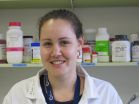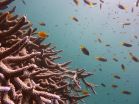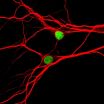Finding the simple patterns in a complex world: ANU media release
2014-12-03
(Press-News.org) An Australian National University (ANU) mathematician has developed a new way to uncover simple patterns that might underlie apparently complex systems, such as clouds, cracks in materials or the movement of the stockmarket.
The method, named fractal Fourier analysis, is based on new branch of mathematics called fractal geometry.
The method could help scientists better understand the complicated signals that the body gives out, such as nerve impulses or brain waves.
"It opens up a whole new way of analysing signals," said Professor Michael Barnsley, who presented his work at the New Directions in Fractal Geometry conference at ANU.
"Fractal Geometry is a new branch of mathematics that describes the world as it is, rather than acting as though it's made of straight lines and spheres. There are very few straight lines and circles in nature. The shapes you find in nature are rough."
The new analysis method is closely related to conventional Fourier analysis, which is integral to modern image handling and audio signal processing.
"Fractal Fourier analysis provides a method to break complicated signals up into a set of well understood building blocks, in a similar way to how conventional Fourier analysis breaks signals up into a set of smooth sine waves," Professor Barnsley said.
Professor Barnsley's work draws on the work of Karl Weierstrass from the late 19th Century, who discovered a family of mathematical functions that were continuous, but could not be differentiated.
"There are terrific advances to be made by breaking loose from the thrall of continuity and differentiability," Professor Barnsley said.
"The body is full of repeating branch structures - the breathing system, the blood supply system, the arrangement of skin cells, even cancer is a fractal."
INFORMATION:
[Attachments] See images for this press release:

ELSE PRESS RELEASES FROM THIS DATE:
2014-12-03
INDIANAPOLIS, December 2, 2014 -- Today, Eli Lilly and Company announced results from new analyses of two Phase 3 trials evaluating the relationship between cognitive and functional treatment effects in patients with mild Alzheimer's disease. Based on post-hoc analyses of the Phase 3 trials, the findings suggested that cognitive deficits were more apparent than functional deficits in mild Alzheimer's disease when measured with the Alzheimer's disease Assessment Scale-Cognitive (ADAS-Cog) and the Alzheimer's disease Cooperative Study-Activities of Daily Living (ADCS-ADL) ...
2014-12-03
Amsterdam, The Netherlands, December 2, 2014 - Detection, prevention, and preclinical treatment are three key areas that may make a difference in the battle to reduce the rapid rise of new Alzheimer's disease (AD) cases every year. These three topics are the focus of an important new supplement to the Journal of Alzheimer's Disease.
Organized by Guest Editor Jack de la Torre, MD, PhD, Professor of Neuropsychology at The University of Texas at Austin, the supplement is a novel guide to how Alzheimer dementia may be approached and managed right now, not years from now. ...
2014-12-03
Scientists have released details of a raft of new chemicals with potent anti-malarial properties which could open the way to new drugs to fight the disease.
A new paper in PNAS is the third published by the group at the Australian National University (ANU), which has collaborated with groups from around the globe to uncover potential ammunition in the fight against malaria.
Over 200 million people contract malaria each year, and the parasite that causes the disease has become resistant to most of the drugs currently available.
"The papers show the malaria parasite ...
2014-12-03
A glimmer of hope for corals as baby reef builders cope with acidifying oceans
While the threat of coral bleaching as a result of climate change poses a serious risk to the future of coral reefs worldwide, new research has found that some baby corals may be able to cope with the negative effects of ocean acidification.
Ocean acidification, which is a direct consequence of increased atmospheric carbon dioxide levels, is expected to have a deleterious effect on many marine species over the next century.
An international team examining the impact of ocean acidification ...
2014-12-03
Coral reefs provide a range of benefits, such as food, opportunities for income and education, but not everyone has the same access to them, according to a new study conducted by the ARC Centre of Excellence for Coral Reef Studies (Coral CoE) at James Cook University.
The researchers examined how people from 28 fishing communities in Madagascar, Kenya, Tanzania and Seychelles benefit from the marine environment.
For many years conservation in developing countries has been based on the assumption that improvements in ecosystem conditions, such as increasing coral reef ...
2014-12-03
December 3, 2014 -- Individuals conceived in the severe Dutch Famine, also called the Hunger Winter, may have adjusted to this horrendous period of World War II by making adaptations to how active their DNA is. Genes involved in growth and development were differentially regulated, according to researchers at the Leiden University Medical Center, Harvard University, and Columbia University's Mailman School of Public Health. Findings are published in the journal Nature Communications.
During the winter of 1944-1945 the Western part of The Netherlands was struck by a severe ...
2014-12-03
CHAPEL HILL, NC - UNC School of Medicine researchers have found for the first time a biochemical mechanism that could be a cause of "chemo brain" - the neurological side effects such as memory loss, confusion, difficulty thinking, and trouble concentrating that many cancer patients experience while on chemotherapy to treat tumors in other parts of the body.
The research, published in the Proceedings of the National Academy of Sciences, shows how the common chemotherapy drug topotecan can drastically suppress the expression of Topoisomerase-1, a gene that triggers the ...
2014-12-03
Coffee, apple juice, and vitamin C: things that people ingest every day are experimental material for chemist Eva-Maria Felix. The doctoral student in the research group of Professor Wolfgang Ensinger in the Department of Material Analysis is working on making nanotubes of gold. She precipitates the precious metal from an aqueous solution onto a pretreated film with many tiny channels. The metal on the walls of the channels adopts the shape of nanotubes; the film is then dissolved. The technique itself is not new, but Felix has modified it: "The chemicals that are usually ...
2014-12-03
WASHINGTON, D.C., December 3, 2014--A new report from the American Institute of Physics (AIP) Statistical Research Center has found that the number of Hispanic students receiving bachelor's degrees in the physical sciences and engineering has increased over the last decade or so, passing 10,000 degrees per year for the first time in 2012. The overall number of U.S. students receiving degrees in those fields also increased over the same time, but it increased faster among Hispanics.
From 2002 to 2012, the number of Hispanics earning bachelor's degrees in the physical sciences ...
2014-12-03
TALLAHASSEE, Fla. -- A team led by Florida State University researchers has identified DNA elements in maize that could affect the expression of hundreds or thousands of genes.
"Maybe they are part of the machinery that allows an organism to turn hundreds of genes off or on," said Associate Professor of Biological Science Hank Bass.
Bass and Carson Andorf, a doctoral student in computer science at Iowa State University, began this exploration of the maize genome sequence along with colleagues from FSU, Iowa State and the University of Florida. They wanted to know ...
LAST 30 PRESS RELEASES:
[Press-News.org] Finding the simple patterns in a complex world: ANU media release





